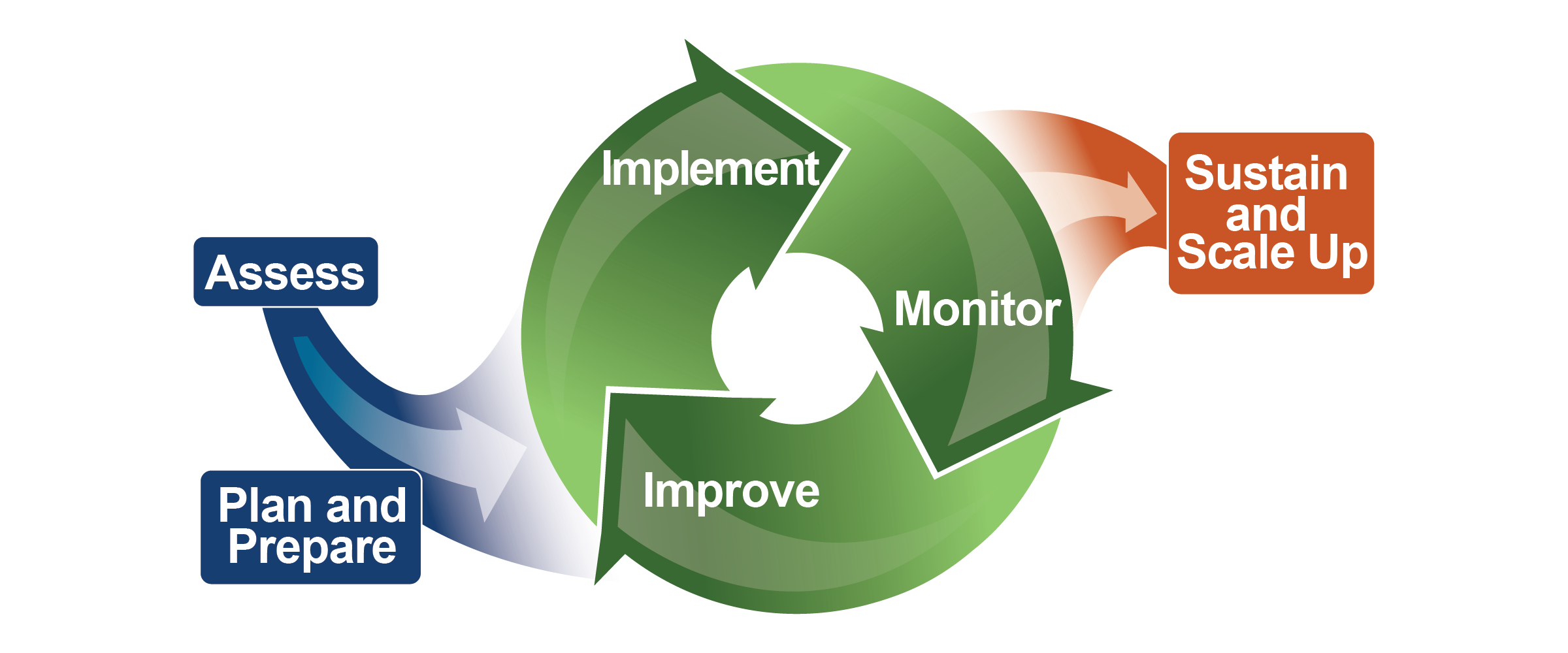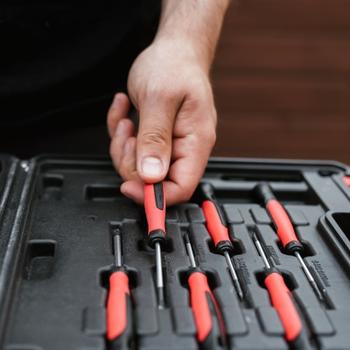By Jason LaTurner, PhD
March 15, 2021
Given all that has occurred in the last year since the COVID-19 pandemic began, the amount of change and innovation in school districts has been at never before seen levels. All of us working in K–12 education have been in a rapid cycle of learning as we do our best to support staff and students.
At the Region 9 Comprehensive Center (R9CC), we have been doing our fair share of learning and adapting amid the pandemic, but our evidence-based technical assistance model has remained a cornerstone for all project work. And because continuous improvement is at the center of our approach, it is inherently flexible. The model has three phases:
- Assess and prepare
- Implement, monitor, and improve
- Sustain and scale up
This evidence-based technical assistance model has been a crucial tool in guiding R9CC’s capacity-building work with state education agencies and districts during the last year. Similarly, district and school leaders may find it a useful approach to guide plans for professional learning, whether during the pandemic or in what we hope will be calmer times ahead. This article digs into each phase of the model and describes some of the tools that R9CC uses that may be useful in designing professional learning for teachers and school staff.
Phase 1: Assess and Prepare
In Phase 1, we assess needs and then prepare to do the work. We begin by assessing the situation using approaches such as a root-cause analysis to determine what support a school or district needs. Often, the problem and/or its cause is unclear, so determining what is at the root of the issue allows us to provide the appropriate support aligned to the need. As we prepare to do the work, we start with an intake process that includes asking several key questions to help determine readiness and highlight the high-leverage problem that our partner may be trying to address. Two sample questions include:
- How does this work align with your strategic plan and/or Every Student Succeeds Act consolidated state plan?
- What will success look like for this project?
Another resource you may find useful is the hexagon tool, which allows you to examine whether folks are ready and able to implement the intended supports or programs, and if not, what additional support might be needed at the beginning of the process to lay the groundwork for long-term success. Too often, folks may be using a hammer for a problem best addressed with a screwdriver, and they may not know how to properly use either tool. Both root-cause analysis and the hexagon tool help uncover the full story so that leaders can tailor support or professional learning plans to align with what teachers need to know so they can be the best “hammer” users possible.
More generally, we recommend taking some time at the beginning of projects to build out a plan on why you think your actions will achieve the intended results. A theory of action and/or logic model process can provide a map that links actions or professional learning activities to the intended results. This process checks to make sure the work will result in the outcomes and allows professional learning participants to see the full picture of the work and how you intend to measure success. Two resources to help you build a logic model include the seminal work of the W. K. Kellogg Foundation and a very practitioner friendly approach called the Tearless Logic Model. Either resource will help you align professional learning to specific outcomes for teachers and, in doing so, ensure that you are investing time and energy in ways aligned with the problem at hand.
Phase 2: Implement, Monitor, and Improve
The core of R9CC’s evidence-based technical assistance model—Phase 2—is a continuous improvement process, in which we seek to implement, monitor, and improve our work. We know that supporting the implementation of a new policy, program, practice, or intervention is difficult, complicated, and resource intensive. We also know that this requires flexible support so that the change process aligns with each unique context. What works in Chicago may not be successful in Iowa City, without some modifications. More generally, the continuous improvement process allows us to identify the practices, tools, and resources that are working and in which contexts they work best—essentially, what types of “hammer” and “nails” are needed to do the work. The same is true for school and district leaders’ work to provide support and professional learning for teachers.
One continuous improvement approach involves using an ongoing Plan-Do-Study-Act (PDSA) process as part of a regular check-in to see how things are progressing. Largely begun in the health field, our American Institutes for Research colleagues created a guidebook and conducted a study on the use of PDSA in education. This work also enables education leaders to hear from, modify, and support teachers in a community of practice. Combined with a logic model, a PDSA process can help keep the team on track and ensure that you continue to use the right strategies. You may learn that you perhaps need a new type of hammer or should be using a different tool (or professional learning approach) altogether.
In addition to monitoring the work, we highly recommend checking in with staff on how they are doing individually. Although the system as a whole may be ready and able to do something new, regular check-ins with staff using a tool such as the Stages of Concern allow education leaders to assess and respond to any issues that staff may have as they engage in their work. This process is powerful because it includes teachers’ voices in the process and further increases leaders’ ability to provide them with the professional learning that they need to best serve their schools or classrooms.
Phase 3: Sustain and Scale Up
As we seek to sustain or scale up our work in Phase 3, it is important to first determine if we accomplished what we set out to do: Did our support or professional learning actually help? Did the hammer drive the nails effectively? As discussed previously, a logic model can provide the first step in building an evaluation plan that examines the following questions:
- Did the work go as intended?
- What worked well in this context?
- Will it work in other schools?
- Did it help all students?
- What modifications are needed?
This step can be particularly important when providing professional learning to teachers—given all that goes into a training and teacher practice—so that you can home in on whether the support led to a change in teachers’ actions. Using a logic model or other fidelity tools to examine the training or program can help link your actions to your outcomes. Building and executing an evaluation does take time and expertise, but numerous small and large organizations can assist in that process. A good place to start is the American Evaluation Association. You can also check out tools from the Regional Educational Laboratory Program on evaluating networked improvement communities and assessing the health of research–practice partnerships.
If the professional learning was successful with solid outcomes, our attention then turns to sustaining the work over multiple years or expanding it to other schools. The National Implementation Research Network has several evidence-based briefs on how to scale up an approach to other schools or districts. Once we get to this final stage, the process begins again: We go back to our toolbox to determine how we can plan for ongoing work in a second year or at a new school.
We are not certain what the “new normal” may hold in the near term, but we hope this quick summary puts some new tools in your professional learning toolbox. Please don’t hesitate to reach out if you have any questions.
Jason LaTurner, PhD, leads the Region 9 Comprehensive Center’s Continuous Improvement for Implementation of IL-EMPOWER Project with the Illinois State Board of Education and is a principal technical assistance consultant at the American Institutes for Research. Dr. LaTurner has more than 20 years of experience supporting state and local education agencies in scoping, assessing, and managing various initiatives, with a particular focus on helping staff manage change.
Photo courtesy of Pexels/Anete Lusina.
